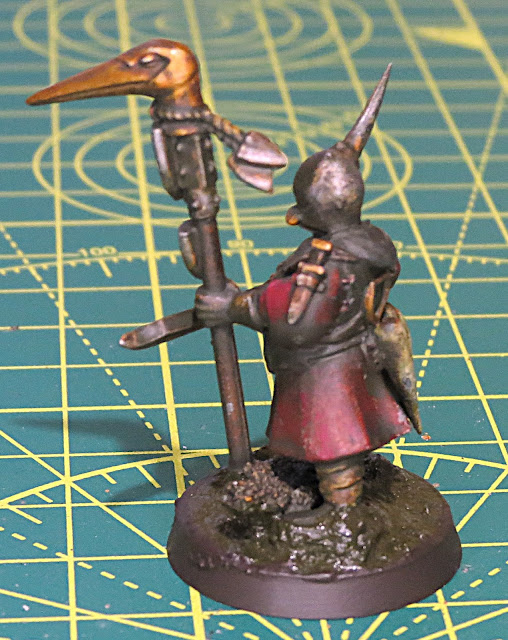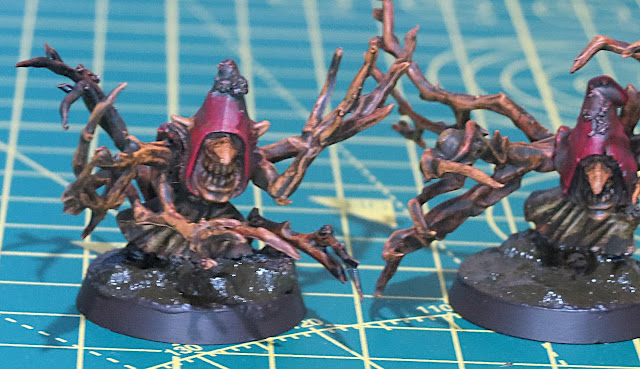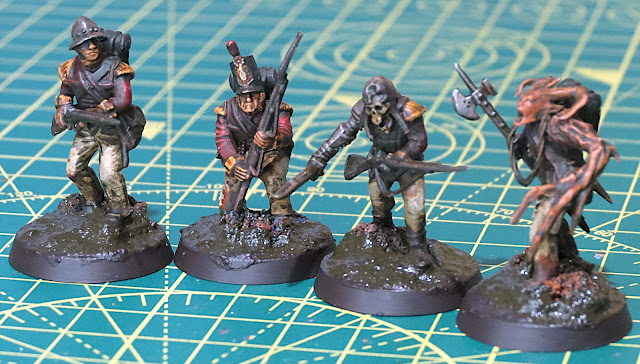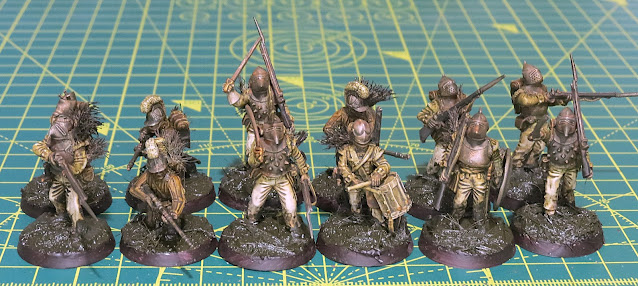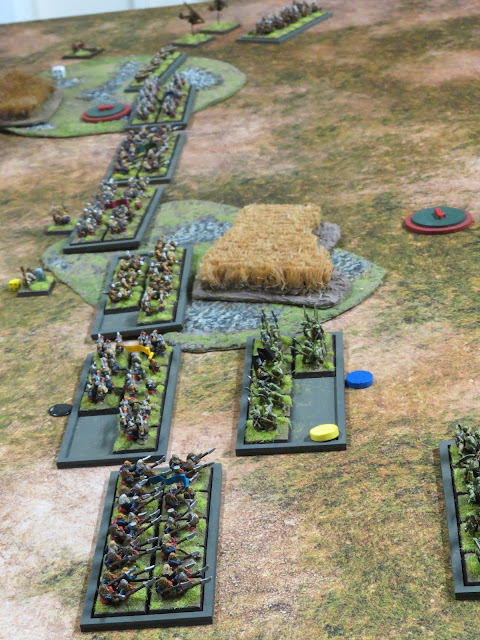2024 was a bit of an odd year for me, for <reasons>
and it meant that I didn’t get much blogging done.
2025 is a new year and we have some significant plans for
gaming in the year. I hope they come to
pass, but whatever happens I’m hoping to blog more consistently.
Kicking off with our first session, this evening we diverted
into One Page Rules (OPR) Regiments. OPR
has been a solid standard in our gaming schedule for a few years now and its an
excellent suite of simple and playable rules.
Regiments is something we’ve not tried much of, so here we
go. During 2024 I spent some
time using up the 10mm miniatures I had left over from my Warband Fantasy
armies, and I had enough to put together an orc army and their traditional
adversaries, the dwarves. As these were ‘what I have left’, rather than planned
lists it meant that they are not in OPR terms ‘competitively validated’, but no
worries. In 10mm I roughly had 4 figures to a single base, with each base being
a single figure in game terms.
So we set out with a test game, and therefore no scenario
involved. We put some basic terrain down and ran our standard ‘5 objective in
an X’ to determine victory.
I handed over the armies to my friends and took the role of
arbiter, remembrancer, and keen observer as to how OPR:R runs.
The armies
Orcs
Dwarves

Deployment
Both teams set up in batches of three units. This is a
variance to OPR’s rules, but we tend to do it this way to save time. It works
for us. Both sides deployed an extended line with solid unit matches. A couple
of tactical observations. The dwarves placed their cannons on the flanks in a
move that would prove lethal. The orcs deployed their heavy hitting giants and
swamp beast in the reserve line, which would see them get the worst of the
early game.
Turn 1
The dwarves kicked off proceedings with their cannons
obliterating both units of orc cavalry! It was interesting that both sides immediately
prioritised their shooting units to try to thin out the opponent’s ranks, with
good effect. In any game the dice play a
factor and throughout this game the dwarf players were rolling far better than
the orcs. This played a frustrating part of the engagement, especially for the
orcs who would struggle to make headway against the winds of randomness.
 |
| Hmm...shouldn't those giants be leading the orc battle line? |
Following the archery exchange, the melee units of both
sides, hampered by bad terrain advanced as best they could.
With the orc flanking losses, the turn ends with objective
control as follows:
Dwarves control 2
Orcs control 1
Turn 2
The short-legged dwarves being slow moving, struggle to make
progress and so the orcs storm across the table smashing into the dwarf
lines. The early combats are brutal with
heavy losses on both sides, but the orcs get the worst of it. The dwarves cost very
similar points to the orcs but are a better quality and this is telling. We assume the points are similar due to the
dwarves being slow, but overall, the feeling in our groups was that the
slowness doesn’t significantly impair them to compensate for the better
quality. The orcs really struggled to
stand up to the dwarves in melee as a result.
 |
| That could've gone better for the orcs... |
Also, spears are worth ever point they cost. Striking first
in melee is a HUGE advantage and the players very quickly simply refused to
charge into the front of a spear armed unit.
The orcs sought out non-spear armed units to attack instead. I feel like
the spears special ability is very strong and probably under costed in the army
building.
Dwarves control 2
Orcs control 1
Turn 3
The orc heavy hitters break out into the front lines,
charging hard across the open ground to get to grips with the dwarves.
The swamp beast and both giants finally get into the mix and
smash apart the dwarves’ right flank. The swamp beast advanced alone in the
dwarves’ left flank, weathering repeated shooting, and shredding its way
through the dwarf lines.
 |
| Slithering, poisonous, and horrific monstrous swamp beast makes its way forwards. |
Outside of these big monsters, much of the orc army is
destroyed, as is half the dwarf battle line.
Meanwhile in the centre the dwarf elite hammerers smash their
way through the orcs before them.
The game’s victory conditions remained unchanged though, so
Turn 4 would be the decider. In the other forms of OPR we play, the game is
usually decided by the end of Turn 3, so this was interesting to watch.
Dwarves control 2
Orcs control 1
Turn 4
A scramble of the victory objectives now ensued. The dwarf right
flank was mostly destroyed, but there were few orcs left here too. The few surviving orcs with crossbows
advanced into the teeth of a dwarf cannon crew but are shaken by cannon fire
securing the objective there for the dwarves.
The dwarven gyrocopter air force on their left flank took
control of the objective in the orc lines on that flank.
 |
| Can anyone else hear 'Ride of the Valkyries'...? |
 |
| The final scuffling melee around the swam beast's breakthrough. |
Meanwhile the orc swamp beast rampaged through the dwarf
lines, and despite being reduced to below half its wounds, succeeded at its
morale and loved to capture the dwarf objective on that flank. This would bring
the battle to a draw, but with the dwarves having enough force left in play
they were able to move to contest this objective to secure a narrow win.
Dwarves control 2
Orcs control 1
Conclusion and observations
The Battle
It was a jolly fun fight with the orcs getting battered
throughout and their battle being saved by the big beasts they brought to the
fight. The dwarf cannons began the
horror early for the orcs, pretty much deleting two orc units! After that though
the battle swung back and forth over control of the objectives. Ultimately the
dwarves simply had too much left in the field for the orc remnants to capture
objectives effectively, although they made a good try at it and almost
succeeded!
The rules
OPR remains an excellent system with many versions well
worth playing. Regiments is an interesting beast. We ran it in its basic form,
but for us it lacked a couple of things. The main issue we found was that units
don’t exert a ‘zone of control’ which allowed weird interactions and unit moves
in front of enemy units. As mainly
historical players this jarred with us a bit but its easily house ruled I
think.
The orc and dwarf basic troops were similarly pointed, but
generally the dwarves were superior in combat to the orcs. This was frustrating.
Spears are highly effective.
They effectively stop opponents wanting to charge them as they always
fight first, a massive bonus. It feels like this is too powerful for the points
cost. Aside from this they have the effect of stymying the game’s movement and
frictions as two opposing spear units will tend to stand and look at each other
rather than engaging.
Overall, an interesting try-out for the OPR Regiments rules.
We’re undecided on whether we’ll use these much in future. Time will tell!




